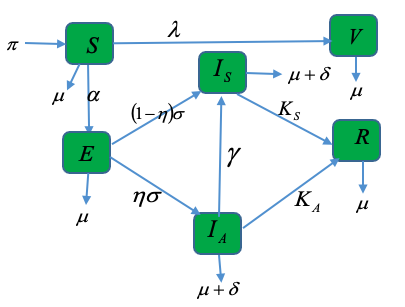A model for the control of transmission dynamics of human monkeypox disease in Sub-Saharan Africa
Keywords:
Human monkeypox, Vaccination, Equilibria, StabilityAbstract
The Human Monkeypox virus has received significant research interest in recent times. While few researchers have studied the effects of vaccination on human-to-animal or animal-to-human Monkeypox transmission, others just studied the effects of treatment on human Monkeypox. In this article, we made the proposition of a deterministic vaccine model that deals with the dynamics of the effects of vaccination and treatment on human Monkeypox in sub-Saharan Africa. We investigated the effects of vaccination on the various epidemiological classes qualitatively. The findings from the analysis of the model are that the model possesses two equilibria, locally asymptotically stable disease-free equilibrium (DFE) when an epidemiological threshold - the effective reproductive number is less than unity, and locally asymptotically stable endemic equilibrium when the number is greater than unity. We then corroborated the theoretical findings with numerical simulations, which reveal that when the rate of vaccination is increased resulting in many newly born persons in the populace being vaccinated, the prevalence of the deadly scourge is significantly reduced, while newly born individuals that miss vaccination experience a drastic torment of the deadly disease that often occasion death. Further revelation from the simulations is that when greater efforts is geared towards vaccination of individuals in the population, the loss of more people to the scourge of the virus would be greatly reduced.

Published
How to Cite
Issue
Section
Copyright (c) 2024 Bolarinwa Bolaji, Abdullahi Ibrahim, Favour Ani, Benjamin Omede, Godwin Acheneje

This work is licensed under a Creative Commons Attribution 4.0 International License.
How to Cite
Most read articles by the same author(s)
- Bolarinwa Bolaji, B. I. Omede, U. B. Odionyenma, P. B. Ojih, Abdullahi A. Ibrahim, Modelling the transmission dynamics of Omicron variant of COVID-19 in densely populated city of Lagos in Nigeria , Journal of the Nigerian Society of Physical Sciences: Volume 5, Issue 2, May 2023







